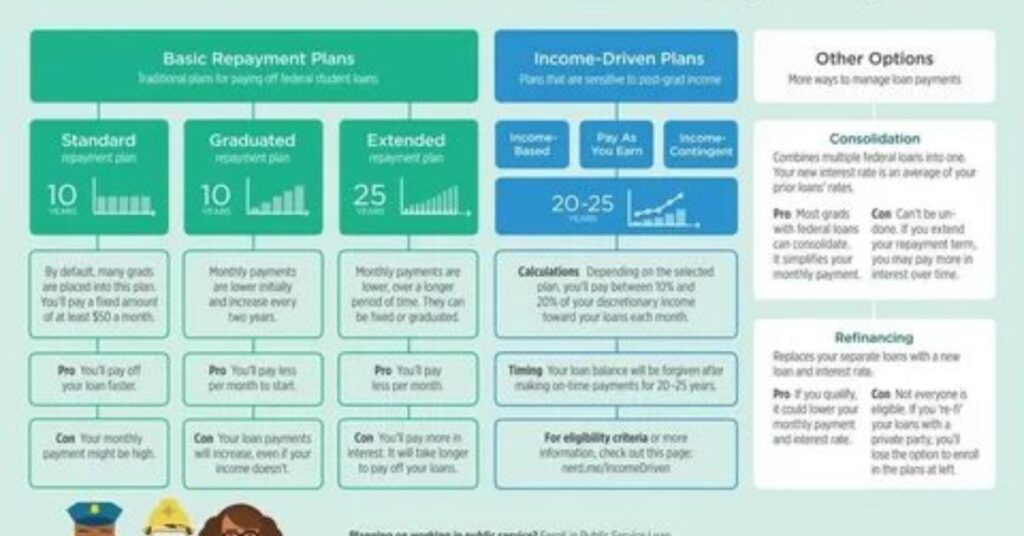In the labyrinth of higher education financing, student loans stand as both a beacon of opportunity and a potential quagmire of debt. For students in the USA, understanding the nuances of Plan 1 and Plan 2 student loans isn’t just important—it’s crucial. These loan plans can shape your financial future long after you’ve tossed your graduation cap in the air. So, let’s dive into the nitty-gritty of Plan 1 and Plan 2 student loans, shall we? What Is A Plan 1 Or Plan 2 Student Loan? A Complete Detailed Guide.
What’s The Difference Between Plan 1 and 2 Student Loans?
If you’re scratching your head wondering about the difference between Plan 1 and Plan 2 student loans, you’re not alone. These two plans are like fraternal twins—related, but with distinct personalities.
Plan 1 loans are the older siblings, introduced before September 1, 2012. They’re the OGs of student financing, if you will. Plan 2 loans, on the other hand, strutted onto the scene for students starting their higher education journey on or after September 1, 2012.
But the differences don’t stop at their birthdates. Let’s break it down:
- Interest Rates: Plan 1 loans typically have lower interest rates. They’re like the steady Eddie of the loan world, with rates that don’t fluctuate as much.
- Repayment Thresholds: Plan 2 loans give you a bit more breathing room before you start repaying. You’ll need to earn more before the repayment kicks in.
- Loan Forgiveness: Both plans offer forgiveness options, but the timelines differ. Plan 2 loans are forgiven after 30 years, while Plan 1 loans are written off when you hit 65.
Here’s a quick comparison table to help you visualize the key differences:
| Feature | Plan 1 | Plan 2 |
|---|---|---|
| Introduction | Before Sept 1, 2012 | On or after Sept 1, 2012 |
| Interest Rate | Lower, more stable | Higher, can fluctuate |
| Repayment Threshold | Lower | Higher |
| Loan Forgiveness | At age 65 | After 30 years |
How Do Plan 1 Student Loans Work?

Plan 1 student loans are like that reliable old car in your driveway—they might not have all the bells and whistles of newer models, but they get the job done. What Is A Plan 1 Or Plan 2 Student Loan? A Complete Detailed Guide.
Who’s on Plan 1?
You’re cruising on the Plan 1 highway if:
- You started your undergraduate course before September 1, 2012
- You’re a Scottish or Northern Irish student who started your undergraduate or postgraduate course on or after September 1, 2012
| Read More About: What Is A Plan 1 Or Plan 2 Student Loan? A Complete Detailed Guide |
What’s the Deal with Plan 1?
Plan 1 loans are the steady Eddies of the student loan world. Here’s the lowdown:
- Interest Rates: These are tied to either the Bank of England base rate plus 1%, or the Retail Price Index (RPI), whichever is lower. It’s like having a financial safety net.
- Repayment Threshold: You start repaying when you earn over £19,895 a year (as of 2021). It’s like a financial rite of passage.
- Repayment Amount: You’ll pay 9% of your income above the threshold. Think of it as a graduate tax, if you will.
The Good, The Bad, and The Ugly of Plan 1
Like any financial product, Plan 1 loans have their pros and cons. Let’s break it down:
The Good:
- Lower interest rates
- Repayments stop if your income drops below the threshold
- Debt is written off at age 65
The Bad:
- Lower repayment threshold means you start repaying sooner
- Interest accrues from the day you take out the loan
The Ugly:
- The debt can feel like a lifelong burden
- It might affect your ability to get other loans or mortgages
As one Plan 1 loan holder, Sarah, puts it: “It’s like having a persistent financial shadow. But at least it’s a predictable one.”
The Basics: Why Student Loans Matter
Before we dive deeper into Plan 2 loans, let’s take a moment to reflect on why student loans matter in the grand scheme of things.
Student loans are the golden ticket to higher education for many. They’re the difference among “I wish I could” and “i am enrolled!” But they’re also a double-edged sword. On one hand, they open doors to education and potentially higher-paying careers. On the other, they can be a financial albatross around graduates’ necks for years to come. What Is A Plan 1 Or Plan 2 Student Loan? A Complete Detailed Guide.
Consider these facts:
- As of 2021, the total U.S. student loan debt is $1.7 trillion
- The common pupil mortgage debt for recent college graduates is almost $30,000
- About sixty five% of college seniors who graduated from public and private nonprofit colleges in 2018 had student loan debt
These numbers aren’t just statistics—they represent real people, real dreams, and real financial challenges. That’s why understanding the ins and outs of Plan 1 and Plan 2 student loans is crucial. It’s not just about getting through college; it’s about setting yourself up for financial success in the long run.
How Do Plan 2 Student Loans Work?
Now, let’s shift gears and talk about Plan 2 loans. If Plan 1 loans are the reliable old car, Plan 2 loans are the newer model with a few more features—and a heftier price tag.
Who’s Rocking Plan 2?
You’re in the Plan 2 club if:
- You’re an English or Welsh student who started your undergraduate course on or after September 1, 2012
- You’re an EU student who started studying in England or Wales on or after September 1, 2012
- You’re studying a postgraduate teacher training course, regardless of when you started or where you lived. What Is A Plan 1 Or Plan 2 Student Loan? A Complete Detailed Guide.
What Makes Plan 2 Tick?
Plan 2 loans dance to a slightly different beat. Here’s the rhythm:
- Interest Rates: These are based on the Retail Price Index (RPI) plus up to 3% depending on your income. It’s like a financial roller coaster—exciting, but potentially scary.
- Repayment Threshold: You start repaying when you earn over £27,295 a year (as of 2021). It’s a higher bar to clear than Plan 1.
- Repayment Amount: Like Plan 1, you’ll pay 9% of your income above the threshold.
The Highs and Lows of Plan 2
Plan 2 loans have their own set of pros and cons. Let’s unpack them:
The Highs:
- Higher repayment threshold means you can earn more before repayments kick in
- Debt is written off after 30 years, regardless of how much you’ve repaid
The Lows:
- Higher interest rates mean your debt can grow faster
- You might end up paying more over the life of the loan
The In-Betweens:
- The higher repayment threshold can mean lower monthly payments, but a longer repayment period
As Tom, a recent graduate with a Plan 2 loan, puts it: “It’s like having a financial personal trainer. The workouts (repayments) are tougher, but you hope you’ll be in better shape in the long run.”
Conclusion
Navigating the world of Plan 1 and Plan 2 student loans can feel like trying to solve a Rubik’s cube blindfolded. But armed with the right information, you can make informed decisions about your financial future.
Remember, whether you’re on Plan 1 or Plan 2, these loans are investments in your future. They’re not just numbers on a page, but stepping stones to your dreams and aspirations.
As you move forward in your educational journey, keep these key points in mind:
- Understand your loan type and its terms
- Keep track of interest rates and how they affect your balance
- Be aware of your repayment threshold and how it impacts your monthly budget
- Consider the long-term implications of your loan on your financial health
The future of student loans is always evolving. As policies change and new plans emerge, stay informed and adaptable. Your financial journey doesn’t end with graduation—it’s a lifelong adventure.
FAQs
Ans: No, you can’t switch between plans. Your plan is determined by when you started your course and where you lived at the time.
Ans: Plan 1 loans generally have lower, more stable interest rates. Plan 2 rates can be higher and more variable, based on your income.
Ans: You’re still responsible for repayments. You’ll need to inform the Student Loans Company and provide details of your income and employment status.
Ans: Yes, both plans offer forgiveness. Plan 1 loans are forgiven at age 65, while Plan 2 loans are forgiven after 30 years.





